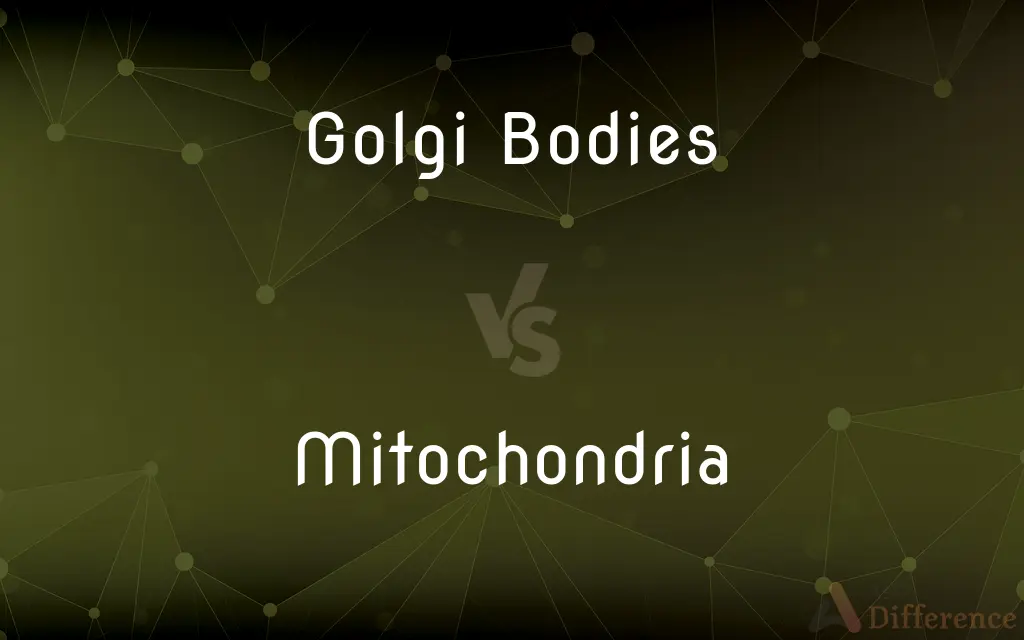Golgi Bodies vs. Mitochondria — What's the Difference?
By Tayyaba Rehman — Published on November 11, 2023
Golgi Bodies sort and package cellular materials, whereas Mitochondria produce energy through ATP synthesis, functioning as cellular power plants.

Difference Between Golgi Bodies and Mitochondria
Table of Contents
ADVERTISEMENT
Key Differences
Golgi Bodies, the cellular post office, diligently manage the shipment of cellular materials, ensuring a systematic workflow within a cell. Mitochondria, on the contrary, are the powerhouses of cells, energizing the cellular activities through meticulous energy production. Both are intrinsic to cellular functioning but differ starkly in their primary roles.
Golgi Bodies stand out as the cell’s packaging center, customizing proteins and lipids, and then preparing them for their specific destinations. Mitochondria, diverging in function, focus on synthesizing ATP (Adenosine Triphosphate), a molecule that carries energy, through a process named oxidative phosphorylation, which starkly differs from the sorting and packaging procedure of the Golgi apparatus.
In Golgi Bodies, vesicles containing cellular materials merge, proteins or lipids within are modified, and then shipped to their locations, ensuring a complex, well-organized transport system. Mitochondria, however, create a cell’s energy, ensuring survival and enabling it to perform various functions, thereby establishing themselves as indispensable for cellular life and vitality.
While Golgi Bodies intricately modify, sort, and package cellular materials, Mitochondria ardently focus on fueling the cell. Despite this variance, both the organelles coexist, maintaining the vitality and sustenance of the cell through their respective and crucial functionalities.
Golgi Bodies emphasize on transportation and modification, ensuring cellular materials reach their destined locations within or outside the cell. Mitochondria, while they don’t engage in packaging or sorting, consistently generate energy, ensuring the cell thrives and executes its functions effectively.
ADVERTISEMENT
Comparison Chart
Primary Function
Sorting and packaging cellular materials.
Producing energy via ATP synthesis.
Structure
Comprised of flattened, stacked membranous sacs.
Composed of a double membrane with a folded inner part.
Genetic Material
Lack their own DNA.
Contain their own DNA and ribosomes.
Creation of Vesicles
Form vesicles to transport cellular materials.
Do not form vesicles for transportation.
Energy Relation
Not directly involved in energy production.
Vital for cellular energy production.
Compare with Definitions
Golgi Bodies
Golgi Bodies play a crucial role in both the synthesis and transport of cellular materials.
Without Golgi Bodies, cells would lack a systematic way to transport and modify cellular materials.
Mitochondria
Mitochondria are cellular organelles that generate most of the cell's supply of adenosine triphosphate (ATP).
Mitochondria enable cellular activities by producing ATP, essential for various cellular processes.
Golgi Bodies
Golgi Bodies ensure that lipids and proteins are suitably modified for their designated pathways.
Golgi Bodies protect the cell by modifying toxins into harmless substances before they cause damage.
Mitochondria
Mitochondria are surrounded by two membranes, an inner and an outer membrane, each having unique properties.
The inner membrane of Mitochondria is folded into cristae, which increases the surface area for ATP production.
Golgi Bodies
Golgi Bodies act as the cellular mailing system, managing the cell's internal and external transport.
The enzymes in Golgi Bodies customize proteins to perform specific functions within the cell.
Mitochondria
Mitochondria, often termed “cellular powerhouses,” play a pivotal role in cellular respiration.
Through oxidative phosphorylation, Mitochondria effectively produce energy that fuels cellular functions.
Golgi Bodies
Golgi Bodies are organelles that modify, package, and transport proteins and lipids.
In the cell, Golgi Bodies ensure that proteins are modified and sent to their correct destinations.
Mitochondria
Mitochondria contain their own DNA and can replicate independently within a cell.
Mitochondria, with their own DNA, can replicate and increase in number within cells under specific conditions.
Golgi Bodies
Golgi Bodies consist of a series of flattened membranous sacs known as cisternae.
Golgi Bodies precisely alter cellular materials and then vesicles transport them to their destinations.
Mitochondria
A spherical or elongated organelle in the cytoplasm of nearly all eukaryotic cells, conning genetic material and many enzymes important for cell metabolism, including those responsible for the conversion of food to usable energy.
Mitochondria
Plural of mitochondrion
Muscles contain many mitochondria so that they can have large energy supplies.
Mitochondria
.
The mitochondria is the powerhouse of the cell.
Common Curiosities
Do Golgi Bodies and Mitochondria have their own genetic material?
No, Golgi Bodies do not have their own genetic material, whereas Mitochondria contain their own DNA and ribosomes.
What is the primary function of Golgi Bodies?
Golgi Bodies modify, sort, and package proteins and lipids for either intra- or extracellular transportation.
How are Golgi Bodies structured?
Golgi Bodies are composed of cisternae, which are flat, stacked pouches involved in the sorting and modification of proteins and lipids.
Are Mitochondria involved in the synthesis of lipids?
Yes, Mitochondria are involved in the synthesis of certain lipids and also the metabolism of fatty acids.
Can Mitochondria exist independently outside the cell?
No, while Mitochondria have their own DNA, they are not capable of independent life and function symbiotically within a cell.
What crucial process occurs in the Mitochondria that impacts cellular respiration?
Mitochondria carry out oxidative phosphorylation, a key process in cellular respiration that generates ATP.
What happens to proteins after they are modified in the Golgi Bodies?
After modification, proteins are transported via vesicles to their destined locations, which could be inside or outside the cell.
Are Golgi Bodies involved in the process of apoptosis?
Not directly, Golgi Bodies mainly focus on modifying and transporting cellular materials, while Mitochondria play a role in apoptosis.
How do Mitochondria contribute to a cell’s function?
Mitochondria primarily produce adenosine triphosphate (ATP), supplying energy for various cellular activities.
Is the number of Mitochondria constant in a cell?
No, the number of Mitochondria can change, often increasing in cells with high energy demands.
What is the relationship between the endoplasmic reticulum and Golgi Bodies?
The endoplasmic reticulum synthesizes proteins and lipids, which are then transported to the Golgi Bodies for further modification and sorting.
What role do Mitochondria play in muscle cells?
In muscle cells, Mitochondria provide the necessary ATP for muscle contraction and endurance during physical activity.
How do Golgi Bodies contribute to the secretory pathway in cells?
Golgi Bodies receive proteins and lipids from the endoplasmic reticulum, modify them, and then direct them to their final destinations via vesicles.
Can cells survive without Golgi Bodies?
While crucial, some cells, like red blood cells, function without Golgi Bodies but generally, they play vital roles in the survival and functionality of a cell.
Share Your Discovery

Previous Comparison
Cherry Wood vs. Mahogany
Next Comparison
Online Learning vs. Classroom LearningAuthor Spotlight
Written by
Tayyaba RehmanTayyaba Rehman is a distinguished writer, currently serving as a primary contributor to askdifference.com. As a researcher in semantics and etymology, Tayyaba's passion for the complexity of languages and their distinctions has found a perfect home on the platform. Tayyaba delves into the intricacies of language, distinguishing between commonly confused words and phrases, thereby providing clarity for readers worldwide.












































